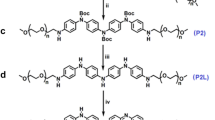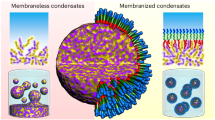Abstract
A-B-A-type block copolymers were prepared by the polymerization of γ-benzyl L-glutamate NCA (A segment) using polyoxypropylene (POP, B segment) with amino groups at both ends of a chain as an initiator. Thrombus formation on the block copolymer films was minimum on a block copolymer containing a POP segment of 50 mol%. It was found that on the block copolymer, denaturation of plasma proteins such as albumin and fibrinogen upon adsorption was sufficiently low not to activate adhered platelets, leading to a low degree of thrombogenesis. The oxygen permeation coefficients (P) of block copolymer films in water were about twice as large as that of poly(γ-benzyl L-glutamate) (PBLG) film. The increased permeation was ascribed to an increased diffusion coefficient (D) of dissolved oxygen through the block copolymer films. Arrhenius plots of P and D showed a break point in the temperature range of 20–30°C. At lower temperatures than the break temperature, the activation energy for oxygen permeation of the block copolymer film was lower than that of PBLG film.
Similar content being viewed by others
Article PDF
References
T. Okano, M. Katayama, and I. Shinohara, J. Appl. Polym. Sci., 22, 369 (1978).
T. Kumaki, M. Sisido, and Y. Imanishi, J. Biomed. Mater. Res., 19, 785 (1985).
Y. Sakurai, T. Akaike, K. Kataoka, and T. Okano, in “Biomedical Polymers,” E. P. Goldberg and A. Nakajima, Ed., Academic Press, New York, N.Y., 1980, p 335.
H. Tanzawa, “Biocompatible Polymers,” in “Biomedical Polymers (Japanese),” Kyoritsu Shuppan, Tokyo, 1978.
I.-K. Kang, Y. Ito, M. Sisido, and Y. Imanishi, Biomaterials, in press.
M. Yokoyama, T. Nakahashi, T. Nishimura, M. Maeda, S. Inoue, K. Kataoka, and Y. Sakurai, J. Biomed. Mater. Res., 20, 867 (1986).
T. Okano, M. Uruno, N. Sugiyama, M. Shimada, I. Shinohara, K. Kataoka, and Y. Sakurai, J. Biomed. Mater. Res., 20, 1035 (1986).
N. Yui, K. Sanui, N. Ogata, K. Kataoka, T. Okano, and Y. Sakurai, J. Biomed. Mater. Res., 20, 929 (1986).
Y. Isono, H. Tanisugi, K. Endo, T. Fujimoto, H. Hasegawa, T. Hashimoto, and H. Kawai, Macromolecules, 16, 5 (1983).
Y. Kitazaki and T. Hata, Adhesion, 8, 131 (1972).
Y. Imai and A. Nosé, J. Biomed. Mater. Res., 6, 165 (1972).
Y. Ito, M. Sisido, and Y. Imanishi, J. Biomed. Mater. Res., 20, 1139 (1986).
Y. Ito, M. Sisido, and Y. Imanishi, J. Biomed. Mater. Res., submitted.
I.-K. Kang, Y. Ito, M. Sisido, and Y. Imanishi, Biomaterials, in press.
I.-K. Kang, Y. Ito, M. Sisido, and Y. Imanishi, Int. J. Biol. Macromol., submitted.
W. A. Zisman, in “Contact Angle, Wettability and Adhesion,” Advanced Chemistry Series 43, The American Chemical Society, Washington D. C., 1964, p 1.
Y. Oohashi, H. Hamano, T. Yoshida, Y. Tsujita, and A. Takizawa, J. Appl. Polym. Sci., 22, 1469 (1978).
Author information
Authors and Affiliations
Rights and permissions
About this article
Cite this article
Kang, IK., Ito, Y., Sisido, M. et al. Synthesis, Blood Compatibility, and Gas Permeability of Block Copolymers Consisting of Polyoxypropylene and Poly(γ-benzyl L-glutamate). Polym J 19, 1329–1339 (1987). https://doi.org/10.1295/polymj.19.1329
Issue date:
DOI: https://doi.org/10.1295/polymj.19.1329



